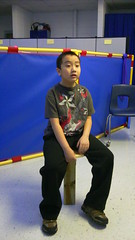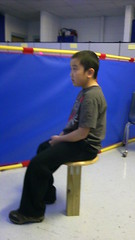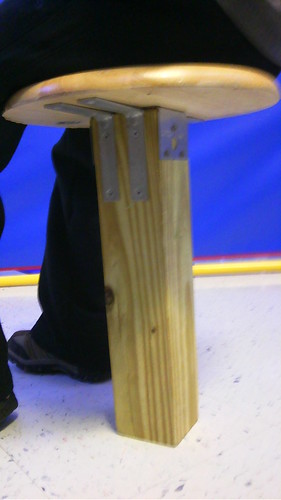I have a student who is constantly "crouching" in his chair with both feet in the seat. He also frequently slams his body against the back of the chair with great force and likes to sit with his chair tipped back with the front legs off of the floor. This may not be a problem sometimes but this particular student is unable to focus on anything while he wiggles and rocks in his chair, he gets so caught up in his movement that he zones out of everything else. I wanted to try a T-stool with him because it would force him to keep his feet on the floor to balance, allow him to wiggle a little bit, and since it doesn't have a back it would stop his body-slamming.
My daddy, master classroom carpenter, came to the rescue once again :-) He built this T-stool for one of my students using the top/seat from a broken bar stool. He made the base (the "leg") wider than a typical T-stool but so far it works very well for my student.



T-Stool
Toothpaste
Sometimes I have a stroke of brilliance that may not seem as exciting and brilliant to your average person. And I often find myself doing things that most people never do. But sometimes there are at least a few other people who do those things and that stroke of brilliance may help them out. And at the risk of making the majority of the world wonder if I've completely lost my mind, I decide to share that idea in the hopes that it will help someone out. This is one of those things. You may think I'm totally nuts, or you may find this to be helpful (or you may think "I've been doing that for years, what's the big deal?")
Students with more severe forms of Autism Spectrum Disorders often need to work on functional, daily-living skills at school. One such skill - brushing teeth - is, I'm sure, practiced in many classrooms. The fact that my students work on brushing teeth isn't the weird part. :-)
I found that many of my students (and probably lots of typical kids, too!) squeeze WAY too much toothpaste on their toothbrush. And toothpaste (if you've ever had tablespoons of it smeared on the bathroom counter you already know this) is incredibly difficult to clean up! So I set out to find a way to keep my kids from making giant sticky blue messes while wasting several dollars worth of toothpaste each week - that would still allow them to develop independence in brushing their teeth. My first thought was - Mentadent! It comes in a pump that only dispenses a small amount per pump - pumping is more difficult than squeezing and makes it easier to control. However, I can't find it ANYWHERE except online and can't find a "kid's" version and I doubt my finicky kids would like it ... so back to the drawing board.
I decided to try travel-size containers of toothpaste - at least then they can only squeeze out so much, which limits the amount they can waste. As they used the travel-size containers, I noticed that as they got closer to emptying the tube, the amount of toothpaste they used was becoming more appropriately sized.
1. Travel-sized toothpaste tubes are expensive, when you consider how much you get in them
2. My students were more successful with almost-empty tubes
So ... I decided to buy large tubes of toothpaste and refill the small tubes - but not refill them completely! For months now I've been making my OWN giant blue sticky mess while I try to refill the small tubes ... and I was wasting quite a bit of toothpaste myself. (Here's where the weird part begins) I woke up in the middle of the night with a flash of genius. Use a syringe!! So this morning I refilled toothpaste containers without making a mess!! And it was SO easy!! So I thought - maybe someone else out there is trying to figure out how to refill travel-size containers of toothpaste in their classroom, too. And this blog post was born. :-)

 I have this toothbrush caddy that I got from Lakeshore, each child has a toothbrush with a cap labeled with their name. They also have their own tube of toothpaste (that way, when they lick the toothpaste straight out of the tube before I can stop them ... I don't have to throw the whole thing away!) with their initial on the cap of the toothpaste. I put little 3 oz cups along the bottom of the toothpaste caddy, put the toothpaste in the cup under each kid's toothpaste. There is also a little basket of bathcloths on the counter.
I have this toothbrush caddy that I got from Lakeshore, each child has a toothbrush with a cap labeled with their name. They also have their own tube of toothpaste (that way, when they lick the toothpaste straight out of the tube before I can stop them ... I don't have to throw the whole thing away!) with their initial on the cap of the toothpaste. I put little 3 oz cups along the bottom of the toothpaste caddy, put the toothpaste in the cup under each kid's toothpaste. There is also a little basket of bathcloths on the counter.Some students come in and get their own toothbrush/toothpaste/cup/cloth, for others I lay out their things by the sink. Some fix their own toothbrushes, others get some help. Some brush independently, others get assistance, etc. After they finish, they throw their cup away and put their cloth in the laundry basket. Some get their own new cup and put their toothbrush/toothpaste/cup away - others give their toothbrush/paste to me (or a para) and we get a new cup and put it all in the caddy.
Another side-note: the toothbrushes I use (and LOVE) are FireFly toothbrushes - you squeeze the bottom and a light in the handle of the toothbrush begins to blink. It blinks for 60 seconds - visually letting my kids know how long they need to brush!
ABLLS-R Resources
The main assessment tool that I use in my classroom is the ABLLS-R, which is an "Assessment, Curriculum Guide and Skills-Tracking System for children with language delays ... based on the science of Applied Behavior Analysis with Skinner's theory of Verbal Behavior along with research by Dr. Partington and includes 25 repertoire areas covering 544 skills." (from Behavior Analysts Inc product description)
In this post, I'm not going to get into an explanation of the assessment or how to administer it (though here is an awesome presentation that does just that), I mainly want to share some of the resources I've found very helpful in using the ABLLS-R, both as a curriculum guide and as an assessment. Even if you do not use the ABLLS-R in your classroom, the resources here will undoubtedly help you in teaching students with ASD. I am, however going to share two points that I think are the biggest selling point for classroom teachers:
While at first glance, the ABLLS-R seems like quite a daunting task to undertake, in the long run it makes life SO much easier in SO many ways!! When working with students who have disabilities, especially autism, we often have difficulty understanding why they can't get to that "next step". We know that students with disabilities often need extra steps between the steps that make up typical developmental progress, but it isn't always obvious what those bridging steps may be. The ABLLS-R breaks down practically every skill that you can think of into smaller steps and makes it easier to see where that "disconnect" is between what the child can already do and what the next "typical step" is. Then we can teach those in-between steps and help the student get to the next big step. It practically writes your present levels or performance as well as IEP goals/objectives which are specific, measurable, attainable, and are directly related to the PLP!
 One of my very favorite parts of the ABLLS-R is that it visually shows the progress that a student has made from year to year on the tracking form in the front of the book. This is very helpful in IEP meetings, to show parents "Everything you see in blue here is something Johnny was not able to do last year but can now do". This gives the parents (and other IEP team members) a very clear overview of the progress a student has made across all domains.
One of my very favorite parts of the ABLLS-R is that it visually shows the progress that a student has made from year to year on the tracking form in the front of the book. This is very helpful in IEP meetings, to show parents "Everything you see in blue here is something Johnny was not able to do last year but can now do". This gives the parents (and other IEP team members) a very clear overview of the progress a student has made across all domains. Like I said, the ABLLS-R can be quite intimidating when you first begin to look into using it - the mind reels when you begin thinking of the data sheets to build, materials to gather, etc. But there's no need to reinvent the wheel!! Here are some resources that will save you time and sanity (though some are free or inexpensive, others are a bit costly but, in my opinion, well worth the money!)
the actual Assessment Manual and Protocol itself can be purchased from several companies, including:
Behavior Analysts (which also offers the WebABLLS which is awesome)
Different Roads to Learning
Western Psychological Services
Data sheets/Tracking:
Autism Concepts has a set of 391 data sheets for the collection of data during lessons that include the objective, mastery definition, response, and the individual skills to meet the objective - available digitally (PDF) or in print
Tracking Sheets has data collection forms for ABLLS and ABLLS-R objectives as well as other resources
Jan Palmer has downloadable tracking graphs in MS excel format
While not specific to the ABLLS-R, many of the data sheets in Sandbox Learning's monitoring materials apply to skills assessed on the ABLLS-R
Flashcards/Materials:
Different Roads to Learning sells a kit with all of the materials needed to complete the ABLLS-R - the kit comes either with or without the assessment manual and protocol. They also have most of the materials in the kit available for purchase outside of the kit - because many classrooms will already have materials for several of the sections.
VB Teaching Tools also sells a kit as well as separate materials.
Autism Concepts has a series of 1003 flash cards with all the photographs and letter/word flash cards required to teach to the ABLLS-R criterion, each labeled with its respective ABLLS-R Objective and numbered for easy retrieval and filing. Comes with a Microsoft Excel spreadsheet indexed to objective, picture number, picture description, and category
Stimulus Publications sells the "Autism Skill Acquisition Program" which contains all of the materials needed to conduct the ABLLS-R
Palmetto PEARL offers on-demand printable flashcards that correlate with the ABLLS-R
Other resources:
Autism Concepts has a set of 392 color coordinated and indexed ABLLS-R Skill Cards to aid instructors in teaching the ABLLS-R skills.
Navigation Behavioral Consulting has several posts about "Understanding the ABLLS-R"
Verbal Behavior - a wiki with tons of helpful stuff, including ABLLS-R tracking grids
Mariposa School offers the Pocket ABLLS for sale
Watch Me Learn videos have kids modeling the skills addressed in the ABLLS-R
What are some of your favorite resources for using the ABLLS-R in your classroom?
Brain Pop
When teaching students with autism, we often struggle to find ways to make the things they "have to learn" (i.e. standards) fun and meaningful to them and how to teach them in a way that interests the students. Brain Pop and Brain Pop Jr. make that SO much easier!!
In my classroom, we watch more than one Brain Pop and/or Brain Pop Jr video most days. There is a video for practically every topic you can think of - and you can search State Standards to find a video that corresponds to whatever you are teaching. The videos on Brain Pop have links to related videos, games/activities, quizes (GREAT for interactive whiteboards) and "More information" (printable information covered in the video) and Brain Pop Jr has "Info for grownups" with ideas and printables for extending the lesson.
My students love Moby (a robot! how autism-friendly is that?) and of course they'd rather watch something on the computer than listen to me talk about it. Check out the free videos and the load of good info on their site -like the Brain Pop for Educators blog and the Grown Up Guide for Brain Pop Jr.
Video Modeling
Video modeling is an effective way to teach many students with autism. When a child will attend to a video (on the television or computer) better than to another person in real life (which is often the case with students who have autism) video modeling is more likely to be successful than in vivo modeling. Additionally, videos allow the student to re-watch certain steps repeatedly, and it frees up the teacher to interact with the child and prompt them (which is difficult to do while simultaneously modeling a behavior!).
Video modeling is especially helpful for those activities or behaviors that you can't model in class (bathing comes to mind) as well as those that are logistically difficult to model frequently (grocery shopping, eating at a restaurant).
One more benefit that I'd like to mention is that video modeling can allow parents, teachers and other therapists to collaborate and use the same method, terminology, etc. when working with a student - we know that students with autism tend to be very literal and have trouble generalizing - if everyone is on the same page, the student can learn the initial skill more quickly and THEN we can work on generalization systematically. Otherwise - if the parents are teaching a student how to do something (let's say put on a jacket), the teacher is teaching another way, and the OT is working on a different way, the child is less likely to learn the skill because they aren't getting consistent practice. And let's face it, trying to write out exactly what you're doing so that another person can try to replicate your instruction is tedious and maybe even impossible. If you use a video and everyone is working from the same video, all teachers/therapists/parents/etc. are doing the same thing with the child and the child will be more likely to experience success!
Video modeling can be used to teach (or review) many types of skills - academic, social, self-help, community, play and more.
I am a huge fan of the "Special Kids" videos - my students love "Mr. John" and they have learned a lot from his videos.
Other places you can find video modeling videos:
- YouTube I searched autism + "video modeling"
- Model Me Kids
- Social Skill Builder
- Watch Me Learn (*now has an
iPhone app!)
It's also very easy to make your own videos modeling things using the exact wording and steps that you want to include. (Perhaps you are working with a lower functioning student and you need each step broken down and described more than in the video you found - or you have a student who can do most of the steps independently and you only need certain steps described and broken down).
Here are two videos I made modeling the steps to washing hands and brushing teeth.
(I want to point out that when you make your own videos, you should do what I didn't do and make sure you have everything set up beforehand - we did this after school and we had already cleaned up the bathroom for the custodians to mop - so the trash can and laundry basket weren't under the counter for the toothbrushing video)
Additional resources:
Here is a video from a conference about video modeling and
Here is a book about video modeling.






